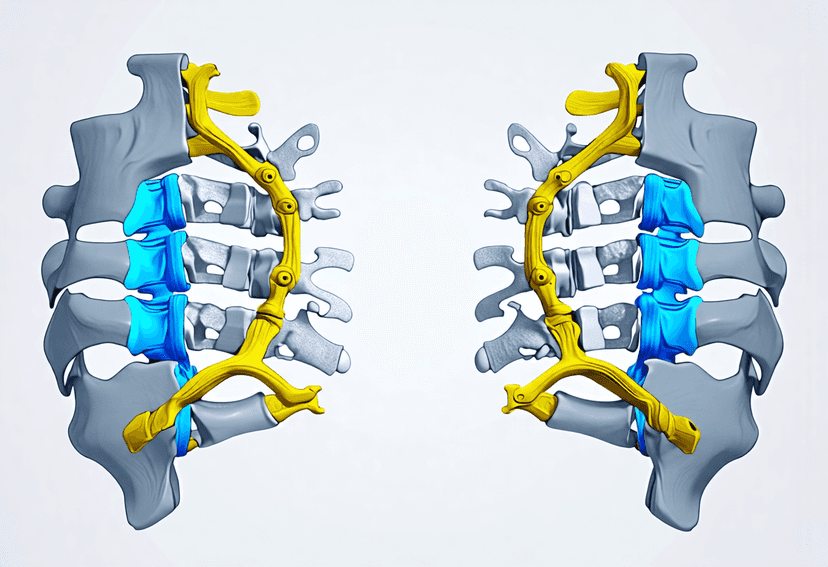الحزم تبدأ من
$6500
هل تحتاج إلى مساعدة في اختيار الحزمة المناسبة لرحلتك الطبية؟
بياناتك الصحية محمية معنا

تحويل الحياة بـ مستوى اندماج الجسم القطني عبر الفتحة (TLIF1
دمج الفقرات القطنية عبر الثقب (TLIF) هو إجراء جراحي يستخدم لتثبيت فقرات العمود الفقري وإزالة الحركة بينها لتخفيف الألم الناجم عن اضطرابات العمود الفقري المختلفة. تستهدف هذه الطريقة على وجه التحديد منطقة القطني (أسفل الظهر) وتتضمن الوصول إلى العمود الفقري من خلال الثقبة ، حيث تخرج جذور الأعصاب من العمود الفقري. غالبًا ما يوصى بهذا الإجراء لحالات مثل مرض القرص التنكسي، أو الأقراص المنفتقة، أو انزلاق الفقار، أو الجنف، أو تضيق العمود الفقري التي لم تستجب للعلاجات المحافظة.
نظرة عامة على الإجراء:
- تقنية: يتضمن TLIF إزالة القرص التالف لتخفيف الضغط على جذور الأعصاب المضغوطة. ثم يقوم الجراح بإدراج طعم عظمي في مساحة القرص بين الفقرات المجاورة. يساعد هذا التطعيم، إلى جانب استخدام القضبان والمسامير للحصول على دعم إضافي، على اندماج العظام مع مرور الوقت. تهدف عملية الانصهار إلى إنشاء عظم صلب واحد يستقر على العمود الفقري ويخفف من الأعراض.
- يقترب: يتم إجراء الجراحة باستخدام نهج خلفي ، حيث يعمل الجراح عبر الظهر ، مما يجعلها أقل إزعاجًا لأعضاء البطن الرئيسية وتقليل وقت الشفاء.
مستويات الشدة والعلاج:
- مستوى 1: عادةً ما ينطوي على اندماج مستوى واحد ، مثل L4 و L5 ، وعادة ما يكون للمرضى الذين يعانون من الألم الموضعي وعدم الاستقرار مع الحد الأدنى من تشوهات العمود الفقري.
- مستوى 2: يتضمن مستويين متجاورين من العمود الفقري، مثل L4-L5 وL5-S1. هذا المستوى مناسب للمرضى الذين يعانون من تغيرات تنكسية واسعة النطاق أو أولئك الذين لم يتم تخفيف أعراضهم عن طريق دمج مستوى واحد.
- مستوى 3: يتضمن هذا المستوى ثلاثة مستويات أو أكثر من العمود الفقري ويتم حجزه للحالات الشديدة مع عدم الاستقرار الكبير في العمود الفقري ، أو التغيرات التنكسية المتقدمة ، أو التشوهات المعقدة مثل الجنف.
استعادة:
- تتضمن الرعاية بعد العملية الجراحية العلاج الطبيعي للمساعدة في تعزيز الظهر وتحسين التنقل. عادةً ما يعاني المرضى من انخفاض كبير في الألم وتحسين الوظيفة أثناء تقدمهم خلال فترة تعافيهم، الأمر الذي قد يستغرق عدة أشهر.
النتائج:
- وقد ثبت أن TLIF يوفر تحسنا كبيرًا في الألم والوظيفة للمرضى الذين يعانون. يعمل على تثبيت العمود الفقري بشكل فعال ويقلل من الأعراض المرتبطة بالحركة بين الفقرات المصابة.
يوفر الاندماج بين اللومبار القطني (TLIF) مقاربة مستهدفة لعلاج ظروف العمود الفقري القطني التي تسمح بالتثبيت الفعال وتخفيف الألم ، وخاصة في الحالات الشديدة التي فشلت فيها العلاجات الأخرى.
4.0
90% مصنف قيمة مقابل المال
لماذا تختارونا؟
98%
معدل النجاح
0
مستوى اندماج الجسم القطني عبر الفتحة (TLIF1 الجراحين
0
مستوى اندماج الجسم القطني عبر الفتحة (TLIF1
0
المستشفيات في جميع أنحاء العالم
0
الحياة التي تم لمسها
نظرة عامة
دمج الفقرات القطنية عبر الثقب (TLIF) هو إجراء جراحي يستخدم لتثبيت فقرات العمود الفقري وإزالة الحركة بينها لتخفيف الألم الناجم عن اضطرابات العمود الفقري المختلفة. تستهدف هذه الطريقة على وجه التحديد منطقة القطني (أسفل الظهر) وتتضمن الوصول إلى العمود الفقري من خلال الثقبة ، حيث تخرج جذور الأعصاب من العمود الفقري. غالبًا ما يوصى بهذا الإجراء لحالات مثل مرض القرص التنكسي، أو الأقراص المنفتقة، أو انزلاق الفقار، أو الجنف، أو تضيق العمود الفقري التي لم تستجب للعلاجات المحافظة.
نظرة عامة على الإجراء:
- تقنية: يتضمن TLIF إزالة القرص التالف لتخفيف الضغط على جذور الأعصاب المضغوطة. ثم يقوم الجراح بإدراج طعم عظمي في مساحة القرص بين الفقرات المجاورة. يساعد هذا التطعيم، إلى جانب استخدام القضبان والمسامير للحصول على دعم إضافي، على اندماج العظام مع مرور الوقت. تهدف عملية الانصهار إلى إنشاء عظم صلب واحد يستقر على العمود الفقري ويخفف من الأعراض.
- يقترب: يتم إجراء الجراحة باستخدام نهج خلفي ، حيث يعمل الجراح عبر الظهر ، مما يجعلها أقل إزعاجًا لأعضاء البطن الرئيسية وتقليل وقت الشفاء.
مستويات الشدة والعلاج:
- مستوى 1: عادةً ما ينطوي على اندماج مستوى واحد ، مثل L4 و L5 ، وعادة ما يكون للمرضى الذين يعانون من الألم الموضعي وعدم الاستقرار مع الحد الأدنى من تشوهات العمود الفقري.
- مستوى 2: يتضمن مستويين متجاورين من العمود الفقري، مثل L4-L5 وL5-S1. هذا المستوى مناسب للمرضى الذين يعانون من تغيرات تنكسية واسعة النطاق أو أولئك الذين لم يتم تخفيف أعراضهم عن طريق دمج مستوى واحد.
- مستوى 3: يتضمن هذا المستوى ثلاثة مستويات أو أكثر من العمود الفقري ويتم حجزه للحالات الشديدة مع عدم الاستقرار الكبير في العمود الفقري ، أو التغيرات التنكسية المتقدمة ، أو التشوهات المعقدة مثل الجنف.
استعادة:
- تتضمن الرعاية بعد العملية الجراحية العلاج الطبيعي للمساعدة في تعزيز الظهر وتحسين التنقل. عادةً ما يعاني المرضى من انخفاض كبير في الألم وتحسين الوظيفة أثناء تقدمهم خلال فترة تعافيهم، الأمر الذي قد يستغرق عدة أشهر.
النتائج:
- وقد ثبت أن TLIF يوفر تحسنا كبيرًا في الألم والوظيفة للمرضى الذين يعانون. يعمل على تثبيت العمود الفقري بشكل فعال ويقلل من الأعراض المرتبطة بالحركة بين الفقرات المصابة.
يوفر الاندماج بين اللومبار القطني (TLIF) مقاربة مستهدفة لعلاج ظروف العمود الفقري القطني التي تسمح بالتثبيت الفعال وتخفيف الألم ، وخاصة في الحالات الشديدة التي فشلت فيها العلاجات الأخرى.















